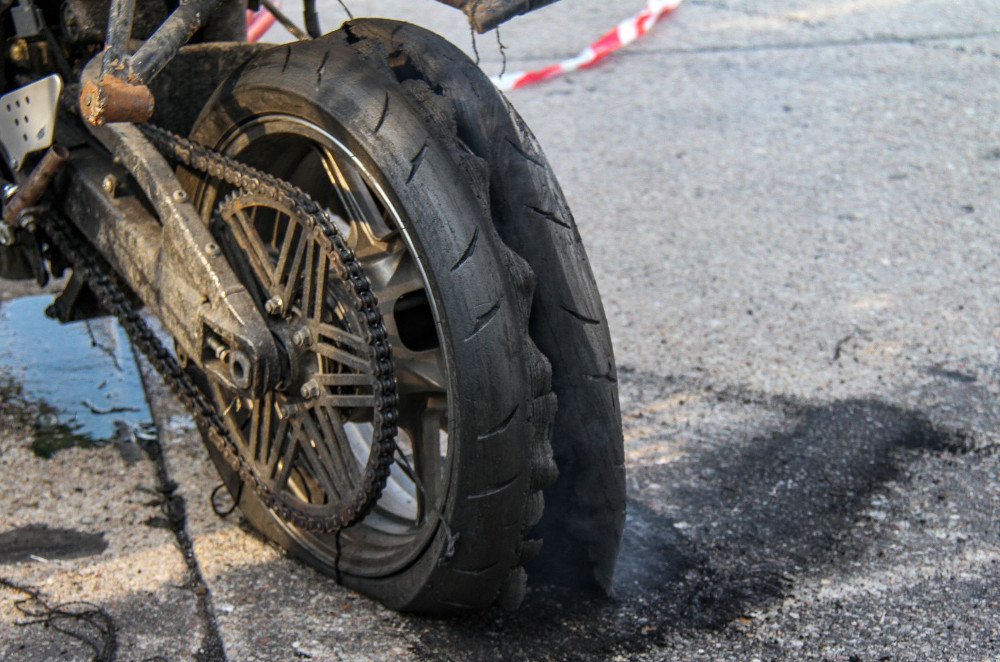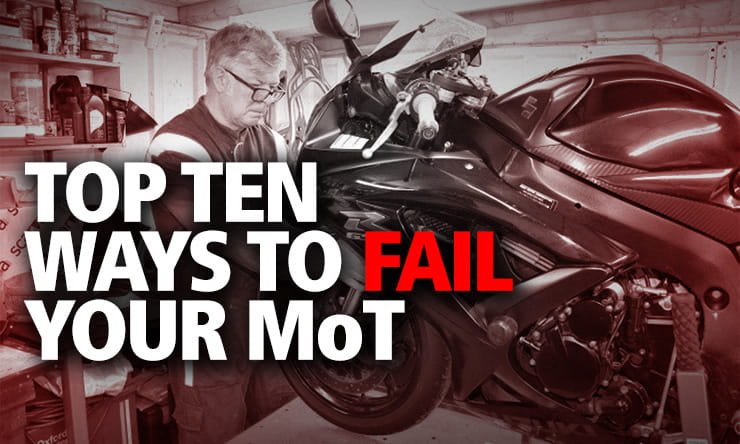If your motorcycle tire blows, gently throttle down and steer straight to safely slow down. Avoid abrupt maneuvers and brake gradually if necessary.
A motorcycle tire blowout can be a startling and dangerous situation for any rider. It’s a scenario that demands immediate action and calm nerves to ensure safety. Every motorcyclist must understand the correct procedures to handle such an event. Maintaining control over the motorcycle during a tire failure is crucial.
The rider’s response can significantly affect the outcome, preventing potential accidents or injuries. This quick guide outlines the vital steps to take if you find yourself dealing with a blown motorcycle tire. Remember, staying informed and prepared is key for any rider facing the unexpected on the road.
Table of Contents
Unexpected Burst: Motorcycle Tire Blowouts
Picture a sunny ride turning tense with a tire burst. Such incidents are rare. Yet, they require quick thinking and calm actions. A blown motorcycle tire needs specific reactions to stay safe. This post delves into crucial steps during these high-stress moments.
Initial Reactions To A Blown Tire
Stay calm and maintain a firm grip on the handlebars once a tire blows. Do not slam the brakes; this could lead to a crash. Instead, slowly ease off the throttle and keep the motorcycle straight. Use engine braking to reduce speed gently.
Safety Protocols During A Tire Failure
- Signal and move to the road’s edge when speed decreases.
- Use brake of the tire that is not blown out. Press it carefully.
- Once stopped, turn on emergency lights. It warns others.
Always carry a puncture repair kit. Wear protective gear every ride. Practice emergency stops during safe conditions to be ready. Being prepared makes a difference during a tire blowout.
Pre-ride Checks To Prevent Tire Blowouts
Pre-Ride Checks play a crucial role in preventing motorcycle tire blowouts. Regular inspections and maintenance can save lives. Learn how to keep tires in top condition and what signs to look for to avoid unexpected issues while on the road. Here’s what you need to know before twisting that throttle.
Inspect Tire Condition Before Hitting The Road
Start every ride with a tire check. Ignoring this can lead to mishaps. A sharp eye can catch many issues before they cause trouble. Tires should look clean, free of cracks, and properly inflated. Use a gauge for accurate pressure. Check for objects that could puncture your tire. This simple routine is your first defense.
You Should Know: Tire Wear And Its Signs
Tire wear isn’t just about losing tread. It reveals your tire’s health. Look for uneven wear patterns and take them seriously. Below are key signs to watch out for:
- Bald spots: Signal of wheel misalignment.
- Cracks in the sidewall: Indicate aging or dry rubber.
- Bulges or blisters: Weak spots that could lead to blowouts.
- Excessive tread wear: Time for a replacement to maintain grip.
The legal tread depth is 1/32 inch. A simple way to measure this is with a penny. Insert it into the tread groove with Lincoln’s head upside down. If you can see all of his head, it’s time for new tires. Remember, safety begins with prevention.
Note age and mileage. Both affect tire integrity. Most manufacturers recommend changing motorcycle tires every five years. Check your manual for mileage guidelines. This ensures top performance and safety.
Tires are a critical component of motorcycle safety. Regular checks maintain their condition and minimize the risk of a blowout. Simple, consistent inspections are the key to a safer ride.

Credit: www.reddit.com
In The Moment: Handling A Blowout
The sudden jolt of a motorcycle tire blowout can be a scary moment for any rider. Staying calm in this situation is crucial. In the moment of a blowout, correct actions can make a big difference. Here’s how to maintain control and safely navigate to a stop.
Maintaining Control Of The Motorcycle
Don’t make sudden moves. A steady grip keeps your bike stable. Use even pressure on the handlebars. Relax your body to absorb the shift in movement.
Keep the motorcycle straight. The bike may pull towards the blowout. Gently guide it back to a straight line. Avoid sharp corrections.
Slowing Down Safely
- Resist the urge to brake hard. Sudden braking could cause a skid. Gently apply the brake on the good tire.
- Use engine braking. Ease off the throttle to let the engine slow you down. Downshift if necessary.
Finding A Safe Spot
Signal your intentions to other drivers. Use hand signals if needed. Look for a clear, flat area to pull over.
Gradually steer the bike to the roadside. Choose a spot away from traffic. Finally, come to a stop and turn the engine off.
Post-blowout Strategies
Moments after a motorcycle tire blowout are crucial for your safety. Quick thinking and the right actions can prevent further damage and injury. In this section, we will explore steps to take immediately after a blowout and how to get assistance.
Assessing The Situation And Damage
Stay calm and keep your grip firm on the handlebars. Bring your motorcycle to a gradual stop. Once safe, conduct a visual inspection of the tire. Look for signs of extensive damage to the motorcycle’s other components. This includes:
- Rim damage
- Brake system issues
- Fluid leaks
- Additional debris from the blowout
Document the damage with photos for insurance or repair purposes.
Options For Assistance And Towing
If the damage is severe and riding is impossible, seek assistance. Here’s what to do:
| Assistance Options | Description |
|---|---|
| Roadside assistance | Check if your insurance offers this service |
| Towing services | Use a search engine to find nearby providers |
| Local motorcycle shops | Some offer pickup for repairs |
| Emergency contacts | Call friends or family who may help |
Remember to use emergency signals if on the road to alert other drivers. You may also use your phone to pinpoint your location for tow services.
Repairing A Motorcycle Tire Post-blowout
Repairing a Motorcycle Tire Post-Blowout is essential to get you back on the road safely. After experiencing a tire blowout, a speedy and effective repair is crucial. Knowing whether to apply a temporary fix or a complete replacement is key. This guide will explore both methods.
Temporary Fixes Versus Complete Replacements
Safety comes first following a blowout. Assessing damage can help choose between a temporary fix or a complete replacement.
- Temporary Fixes may include:
- Emergency plug kits
- Tube patches
- Sealants
- A Complete Replacement involves:
- Buying a new tire
- Professional installation
Temporary fixes are generally for short distances only. Aim for a complete replacement as soon as possible.
Choose The Right Repair Method
Select the suitable repair method based on damage severity and riding demands.
| Repair Method | Use Case |
|---|---|
| Plug Kits/Sealants | Minor punctures, temporary fix |
| Tube Patch | Small cuts or holes in tube tires |
| New Tire | Severe damage, sidewall punctures |
Seek professional advice when in doubt. Your safety is worth the investment.
Prevent Future Tire Blowouts
Preventing future tire blowouts can mean the difference between a safe journey and a potentially hazardous situation on the road. Keeping motorcycle tires in top condition is crucial for any rider’s safety. By implementing a few preventative measures, riders can significantly reduce the risk of experiencing these dangerous incidents.
Regular Maintenance And Care Tips
Consistent upkeep is key to tire longevity and reliability. Follow these straightforward tips to ensure tires remain in excellent condition:
- Regularly check tire pressure. Use a reliable gauge to ensure tires are inflated according to the manufacturer’s specifications.
- Inspect tires for wear and tear. Look for signs of cuts, punctures, or bulges. Tread depth is also vital – replace tires when needed.
- Keep tires clean. Remove debris and dirt from treads to maintain good traction.
- Follow weight limits. Overloading a motorcycle puts extra strain on tires.
- Mind the road. Avoid hazards that can damage tires, like potholes or sharp objects.
- Stay on schedule. Follow the motorcycle’s maintenance guide for regular service.
Upgrae Tires For Enhanced Safety
Investing in higher-quality tires can lead to better performance and improved safety. Consider these factors when upgrading:
| Feature | Benefit |
|---|---|
| Premium Material | Increases tire durability and longevity. |
| Better Tread Design | Improves road grip, especially in wet conditions. |
| Reinforced Sidewalls | Enhances stability and load-carrying capacity. |
Choose tires that suit your riding style and bike model. Always opt for respected brands known for their quality and innovation. Remember to have tires professionally installed for optimal performance and safety.
Road Warrior Skills: Emergency Training
Imagine cruising on your motorcycle, the wind against your face, and suddenly, catastrophe strikes—a tire blowout! The situation demands more than just good reflexes; it requires fluency in emergency maneuvers. Riders, seasoned or beginners, must all respect the unpredictability of the road. This guide offers critical insights into surpassing a tire blowout with poise and precision.
Learning Advanced Riding Techniques
Mastering advanced riding skills is a must for any biker. Such expertise can make the difference between a controlled stop and an unfortunate spill. Let’s dive into techniques vital for tire blowout situations:
- Throttle Control: Maintaining a steady grip can prevent panic acceleration or deceleration.
- Body Positioning: Keeping the body aligned with the bike stabilizes it during sudden loss of tire pressure.
- Braking Mastery: Knowing how to use the front and rear brakes independently is crucial.
- Swerve Techniques: Practice quick, controlled maneuvers to avoid obstacles post-blowout.
- Clutch Control: Learn to disengage the engine quickly to prevent further instability.
Regular training on advanced techniques prepares riders for emergent reactions, building muscle memory and confidence.
Emergency Preparedness Courses For Bikers
Proactive bikers often enroll in emergency preparedness courses. These specialized programs drill into the mind the dos and don’ts during a tire blowout:
| Aspect | Details |
|---|---|
| Simulation Drills | Hands-on practice of tire blowout scenarios in a controlled environment. |
| Mental Conditioning | Techniques to stay calm and think clearly under pressure. |
| Rescue Skills | First aid and basic survival skills, should an accident occur. |
| Post-Incident Protocols | Guidance on next steps following a blowout, including bike inspection and documentation. |
These comprehensive courses go beyond the mechanics of handling a bike, fostering a mindset that prioritizes safety and preparedness.

Credit: revealnews.org
Legal And Insurance Considerations
When a motorcycle tire blows, understanding your legal rights and insurance policy is crucial. It’s not just about getting back on the road, but making sure you’re protected financially and legally. Here, we will delve into what your insurance covers and the legal aspects resulting from tire failure.
Insurance Coverage For Blowouts
Insurance policies vary, so it’s vital to know what yours covers. Some key points include:
- Does your policy cover tire damage or replacement?
- Are blowouts from wear and tear included?
- What about accidents caused by a blowout?
- Check your coverage limits and deductibles.
Always keep a copy of your insurance policy handy. This way, you’ll know your entitlements after a blowout. Reviewing your policy annually ensures you’re always up to date.
Legal Implications Of Accidents Due To Tire Failure
When tire failure leads to an accident, the legal side kicks in. Here’s what you should understand:
| Aspect | Explanation |
|---|---|
| Negligence | If the blowout was preventable, you might be liable. |
| Manufacturer Defect | You could have a claim against the tire’s maker. |
| Documentation | Collect evidence and report to authorities. |
Consult with a legal expert to navigate any issues after a tire blowout accident. They will help you understand your rights and take appropriate action.Tips or other content relevant to what to do if a motorcycle tire blows can be added here, as long as it adheres to the guidelines above.
FAQ
How To React To A Motorcycle Tire Blowout?
Remain calm and grip the handlebars firmly. Avoid sudden braking. Gradually decelerate and steer the bike straight. Pull over when it’s safe.
What Safety Gear Helps In A Tire Blowout?
High-quality helmets, abrasion-resistant clothing, gloves, and boots protect you. They reduce injury risks during a tire blowout and potential fall.
Can Regular Maintenance Prevent Tire Blowouts?
Regular inspections for tire wear, damage, and correct pressure reduce blowout risks. Always check your motorcycle’s tires before long rides for safety.
How To Check Motorcycle Tires For Blowout Risks?
Check tires for cracks, bulges, and wear. Use a pressure gauge to ensure they are inflated to the manufacturer’s recommended level.
Bottom Line
Experiencing a motorcycle tire blowout can be a hassle. Stay calm and steady your bike with firm grips. Safely guide your two-wheeler to a stop. Remember, regular tire inspections reduce such risks. Stay safe on the road by being proactive with your motorcycle’s maintenance.




Leave a Reply